This tutorial demonstrates how to use the vl::RaycastVolume class to render a volume using various raycasting techniques such as Isosurface, MIP and density integration.
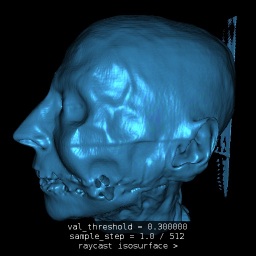
| 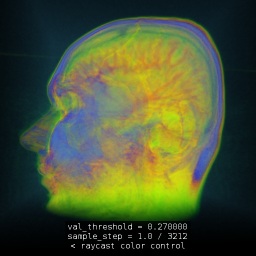
| 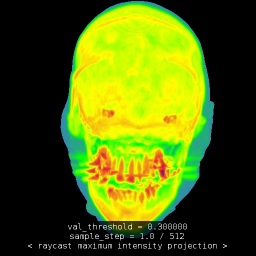
|
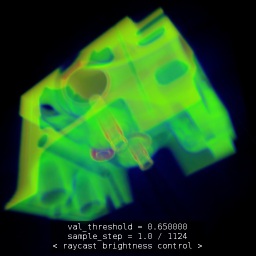
| 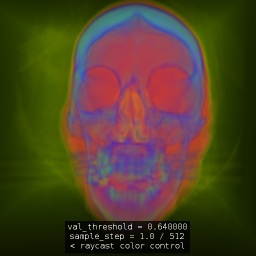
| 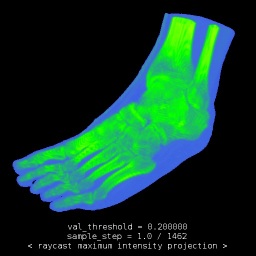
|
The example below demonstrates how to use an arbitrary GLSL program and transfer function to render a volume. The fragment shader used in this example is capable of computing the volume gradient and per-pixel lighting in real-time with up to 4 lights at the same time. It's also capable of taking advantage of a precomputed normal-texture to speedup the lighting computations. You can drag and drop in the window any supported volume data to visualize it. The mouse wheel is used to modifies the rendering based on the specific technique.
- Summary of the technique
Essentally this technique renders a cube with 3d texture coordinates, that is, at each corner of the cube corresponds a corner of the volume texture. We then generate for each interpolated texel the xyz objects space position, to do so we pass such position from the vertex shader to the fragment shader using a 'varying' variable. Once we have such position in the fragment shader we subtract the object space eye position to retrieve the ray vector that goes from the center of the camera through the current fragment. Such vector can then be used to start traversing the volume texture. The starting point of such traversal, in texture coordinates, is simply the 3d texture coordinate of the current fragment. We then iterate through the ray using the particular volume visualization tecnique until we reach one of the borders of the 3D texture.
Note that some tecniques require a front to back ray casting (such as isosuface), some others benefit from a back to front ray casting (integration based methods) and for some others the ray casting direction is indifferent (such as for MIP). To raycast back to front we render the back facing polygons of the cube (so that we start from the furthest away texels) and compute the ray direction as eye.xyz - fragment.xyz. On the other hand, to raycast front to back, we render the front facing polygons of the cube (so that we start from the texels closest to the camera) and compute the ray direction as fragment.xyz - eye.xyz (i.e. we invert the direction).
That's it! The actual code implementing the bare bone infrastructure is surprisingly simple and small, all the rest is glue code and ancillary logic.
[From App_VolumeRaycast.cpp]
#include "BaseDemo.hpp" #include <vlVolume/RaycastVolume.hpp> #include <vlVolume/VolumeUtils.hpp> #include <vlGraphics/Light.hpp> #include <vlGraphics/Text.hpp> #include <vlGraphics/FontManager.hpp> #include <vlGraphics/GLSL.hpp> #include <vlGraphics/GeometryPrimitives.hpp> using namespace vl; /* This example demonstrates how to implement raycasting using the vl::RaycastVolume class and a few ad-hoc fragment shaders. The user has several controls as well: Left/Right arrow keys changes the raycasting mode: - Isosurface_Mode - Isosurface_Transp_Mode, - MIP_Mode - RaycastBrightnessControl_Mode - RaycastDensityControl_Mode - RaycastColorControl_Mode Mouse wheel: - In Isosurface_Mode controls the iso-value of the isosurface - In Isosurface_Transp_Mode controls the iso-value of the isosurface - In MIP_Mode all the volume values less than this are discarded - In RaycastBrightnessControl_Mode controls the brightness of the voxels - In RaycastDensityControl_Mode controls the density of the voxels - In RaycastColorControl_Mode controls the color-bias of the voxels The Up/Down arrow keys are used to higher/lower the ray-advancement precision. The 'L' key toggles the dynamic and colored lights. */ class App_VolumeRaycast: public BaseDemo { /* ----- raycast volume rendering options ----- */ /* The sample step used to render the volume, the smaller the number the better ( and slower ) the rendering will be. */ float SAMPLE_STEP; /* volume visualization mode */ enum RaycastMode { Isosurface_Mode, Isosurface_Transp_Mode, MIP_Mode, RaycastBrightnessControl_Mode, RaycastDensityControl_Mode, RaycastColorControl_Mode } MODE; /* If enabled, renders the volume using 3 animated lights. */ bool DYNAMIC_LIGHTS; /* If enabled 3 colored lights are used to render the volume. */ bool COLORED_LIGHTS; /* Use a separate 3d texture with a precomputed gradient to speedup the fragment shader. Requires more memory ( for the gradient texture ) but can speedup the rendering. */ bool PRECOMPUTE_GRADIENT; public: virtual String appletInfo() { return BaseDemo::appletInfo() + "- Left/Right Arrow: change raycast technique.\n" + "- Up/Down Arrow: changes SAMPLE_STEP.\n" + "- L: toggles lights (useful only for isosurface).\n" + "- Mouse Wheel: change the bias used to render the volume.\n" + "\n" + "- Drop inside the window a set of 2D files or a DDS or DAT volume to display it.\n" + "\n"; } App_VolumeRaycast() { SAMPLE_STEP = 1.0f / 512.0f; MODE = RaycastBrightnessControl_Mode; DYNAMIC_LIGHTS = false; COLORED_LIGHTS = false; PRECOMPUTE_GRADIENT = false; } /* initialize the applet with a default volume */ virtual void initEvent() { vl::Log::notify(appletInfo()); if ( !Has_GLSL ) { vl::Log::error( "OpenGL Shading Language not supported.\n" ); vl::Time::sleep(2000); exit(1); } mLight0 = new Light; mLight1 = new Light; mLight2 = new Light; mLight0Tr = new Transform; mLight1Tr = new Transform; mLight2Tr = new Transform; rendering()->as<Rendering>()->transform()->addChild( mLight0Tr.get() ); rendering()->as<Rendering>()->transform()->addChild( mLight1Tr.get() ); rendering()->as<Rendering>()->transform()->addChild( mLight2Tr.get() ); // volume transform mVolumeTr = new Transform; // val_threshold: manipulated via mouse wheel // - In Isosurface_Mode controls the iso-value of the isosurface // - In Isosurface_Transp_Mode controls the iso-value of the isosurface // - In MIP_Mode all the volume values less than this are discarded // - In RaycastBrightnessControl_Mode controls the brightness of the voxels // - In RaycastDensityControl_Mode controls the density of the voxels // - In RaycastColorControl_Mode controls the color-bias of the voxels mValThreshold = new Uniform( "val_threshold" ); mValThreshold->setUniformF( 0.5f ); // default volume image mVolumeImage = loadImage( "/volume/VLTest.dat" ); setupScene(); } void setupScene() { // scrap previous scene sceneManager()->tree()->eraseAllChildren(); sceneManager()->tree()->actors()->clear(); mLight0->bindTransform( NULL ); mLight1->bindTransform( NULL ); mLight2->bindTransform( NULL ); ref<Effect> volume_fx = new Effect; // we don't necessarily need this: // volume_fx->shader()->enable( EN_BLEND ); volume_fx->shader()->enable( EN_CULL_FACE ); volume_fx->shader()->enable( EN_DEPTH_TEST ); // NOTE // in these cases we render the back faces and raycast in back to front direction // in the other cases we render the front faces and raycast in front to back direction if ( MODE == RaycastBrightnessControl_Mode || MODE == RaycastDensityControl_Mode || MODE == RaycastColorControl_Mode ) { volume_fx->shader()->enable( vl::EN_CULL_FACE ); volume_fx->shader()->gocCullFace()->set( vl::PF_FRONT ); } volume_fx->shader()->setRenderState( mLight0.get(), 0 ); // light bulbs if ( DYNAMIC_LIGHTS ) { // you can color the lights! if ( COLORED_LIGHTS ) { mLight0->setAmbient( fvec4( 0.1f, 0.1f, 0.1f, 1.0f ) ); mLight1->setAmbient( fvec4( 0.1f, 0.1f, 0.1f, 1.0f ) ); mLight2->setAmbient( fvec4( 0.1f, 0.1f, 0.1f, 1.0f ) ); mLight0->setDiffuse( vl::gold ); mLight1->setDiffuse( vl::green ); mLight2->setDiffuse( vl::royalblue ); } // add the other two lights volume_fx->shader()->setRenderState( mLight1.get(), 1 ); volume_fx->shader()->setRenderState( mLight2.get(), 2 ); // animate the three lights mLight0->bindTransform( mLight0Tr.get() ); mLight1->bindTransform( mLight1Tr.get() ); mLight2->bindTransform( mLight2Tr.get() ); // add also a light bulb actor ref<Effect> fx_bulb = new Effect; fx_bulb->shader()->enable( EN_DEPTH_TEST ); ref<Geometry> light_bulb = vl::makeIcosphere( vec3( 0,0,0 ),1,1 ); sceneManager()->tree()->addActor( light_bulb.get(), fx_bulb.get(), mLight0Tr.get() ); sceneManager()->tree()->addActor( light_bulb.get(), fx_bulb.get(), mLight1Tr.get() ); sceneManager()->tree()->addActor( light_bulb.get(), fx_bulb.get(), mLight2Tr.get() ); } // the GLSL program that performs the actual raycasting mGLSL = volume_fx->shader()->gocGLSLProgram(); mGLSL->gocUniform( "sample_step" )->setUniformF( SAMPLE_STEP ); // attach vertex shader (common to all the raycasting techniques) mGLSL->attachShader( new GLSLVertexShader( "/glsl/volume_luminance_light.vs" ) ); // attach fragment shader implementing the specific raycasting tecnique if ( MODE == Isosurface_Mode ) mGLSL->attachShader( new GLSLFragmentShader( "/glsl/volume_raycast_isosurface.fs" ) ); else if ( MODE == Isosurface_Transp_Mode ) mGLSL->attachShader( new GLSLFragmentShader( "/glsl/volume_raycast_isosurface_transp.fs" ) ); else if ( MODE == MIP_Mode ) mGLSL->attachShader( new GLSLFragmentShader( "/glsl/volume_raycast_mip.fs" ) ); else if ( MODE == RaycastBrightnessControl_Mode ) mGLSL->attachShader( new GLSLFragmentShader( "/glsl/volume_raycast01.fs" ) ); else if ( MODE == RaycastDensityControl_Mode ) mGLSL->attachShader( new GLSLFragmentShader( "/glsl/volume_raycast02.fs" ) ); else if ( MODE == RaycastColorControl_Mode ) mGLSL->attachShader( new GLSLFragmentShader( "/glsl/volume_raycast03.fs" ) ); // manipulate volume transform with the trackball trackball()->setTransform( mVolumeTr.get() ); // volume actor mVolumeAct = new Actor; mVolumeAct->setEffect( volume_fx.get() ); mVolumeAct->setTransform( mVolumeTr.get() ); sceneManager()->tree()->addActor( mVolumeAct.get() ); // bind val_threshold uniform to the volume actor mVolumeAct->setUniform( mValThreshold.get() ); // RaycastVolume will generate the actual actor's geometry upon setBox() invocation. // The geometry generated is actually a simple box with 3D texture coordinates. mRaycastVolume = new vl::RaycastVolume; mRaycastVolume->bindActor( mVolumeAct.get() ); AABB volume_box( vec3( -10,-10,-10 ), vec3( +10,+10,+10 ) ); mRaycastVolume->setBox( volume_box ); // val_threshold text mValThresholdText = new Text; mValThresholdText->setFont( defFontManager()->acquireFont( "/font/bitstream-vera/VeraMono.ttf", 12 ) ); mValThresholdText->setTextAlignment( TextAlignCenter ); mValThresholdText->setAlignment( AlignHCenter | AlignBottom ); mValThresholdText->setViewportAlignment( AlignHCenter | AlignBottom ); mValThresholdText->translate( 0,5,0 ); mValThresholdText->setBackgroundEnabled( true ); mValThresholdText->setBackgroundColor( fvec4( 0,0,0,0.75 ) ); mValThresholdText->setColor( vl::white ); ref<Effect> effect = new Effect; effect->shader()->enable( EN_BLEND ); sceneManager()->tree()->addActor( mValThresholdText.get(), effect.get() ); updateText(); // let's visualize the volume! setupVolume(); } /* visualize the given volume */ void setupVolume() { Effect* volume_fx = mVolumeAct->effect(); // for semplicity we don't distinguish between different image formats, i.e. IF_LUMINANCE, IF_RGBA etc. ref<Image> gradient; if ( PRECOMPUTE_GRADIENT ) { // note that this can take a while... gradient = vl::genGradientNormals( mVolumeImage.get() ); } // install volume image as textue #0 volume_fx->shader()->gocTextureSampler( 0 )->setTexture( new vl::Texture( mVolumeImage.get(), TF_LUMINANCE8, false, false ) ); volume_fx->shader()->gocUniform( "volume_texunit" )->setUniformI( 0 ); mRaycastVolume->generateTextureCoordinates( ivec3(mVolumeImage->width(), mVolumeImage->height(), mVolumeImage->depth()) ); // generate a simple colored transfer function ref<Image> trfunc; if ( COLORED_LIGHTS && DYNAMIC_LIGHTS ) trfunc = vl::makeColorSpectrum( 128, vl::white, vl::white ); // let the lights color the volume else trfunc = vl::makeColorSpectrum( 128, vl::blue, vl::royalblue, vl::green, vl::yellow, vl::crimson ); // installs the transfer function as texture #1 volume_fx->shader()->gocTextureSampler( 1 )->setTexture( new Texture( trfunc.get() ) ); volume_fx->shader()->gocUniform( "trfunc_texunit" )->setUniformI( 1 ); // gradient computation, only use for isosurface methods if ( MODE == Isosurface_Mode || MODE == Isosurface_Transp_Mode ) { if ( PRECOMPUTE_GRADIENT ) { volume_fx->shader()->gocUniform( "precomputed_gradient" )->setUniformI( 1 /*true*/ ); volume_fx->shader()->gocTextureSampler( 2 )->setTexture( new Texture( gradient.get(), TF_RGBA, false, false ) ); volume_fx->shader()->gocUniform( "gradient_texunit" )->setUniformI( 2 ); } else { volume_fx->shader()->gocUniform( "precomputed_gradient" )->setUniformI( 0 /*false*/ ); // used to compute on the fly the normals based on the volume's gradient volume_fx->shader()->gocUniform( "gradient_delta" )->setUniform( fvec3( 0.5f/mVolumeImage->width(), 0.5f/mVolumeImage->height(), 0.5f/mVolumeImage->depth() ) ); } } // update text updateText(); // refresh window openglContext()->update(); } /* load files drag&dropped in the window */ void fileDroppedEvent( const std::vector<String>& files ) { mVolumeImage = NULL; if( files.size() == 1 ) // if there is one file load it directly { if ( files[0].endsWith( ".dat" ) || files[0].endsWith( ".dds" ) ) { mVolumeImage = loadImage( files[0] ); if ( mVolumeImage ) setupVolume(); } } else // if there is more than one file load and sort them and assemble a 3D image { // sort files by their name std::vector<String> files_sorted = files; std::sort( files_sorted.begin(), files_sorted.end() ); // load the files std::vector< ref<Image> > images; for( unsigned int i=0; i<files_sorted.size(); ++i ) { images.push_back( loadImage( files_sorted[i] ) ); if (files_sorted[i].endsWith(".dcm")) images.back()->contrastHounsfieldAuto(); } // assemble the volume mVolumeImage = assemble3DImage( images ); // set the volume if ( mVolumeImage ) setupVolume(); } if ( !mVolumeImage ) Log::error("Error loading volume data!\n"); } void updateText() { // update the val_threshold value and the raycast technique name String technique_name; switch(MODE) { case Isosurface_Mode: technique_name = "raycast isosurface >"; break; case Isosurface_Transp_Mode: technique_name = "< raycast transparent isosurface >"; break; case MIP_Mode: technique_name = "< raycast maximum intensity projection >"; break; case RaycastBrightnessControl_Mode: technique_name = "< raycast brightness control >"; break; case RaycastDensityControl_Mode: technique_name = "< raycast density control >"; break; case RaycastColorControl_Mode: technique_name = "< raycast color control"; break; }; float val_threshold = 0; mValThreshold->getUniform( &val_threshold ); mValThresholdText->setText( Say( "val_threshold = %n\n" "sample_step = 1.0 / %.0n\n" "%s" ) << val_threshold << 1.0f / SAMPLE_STEP << technique_name); } void updateValThreshold( int val ) { float val_threshold = 0.0f; mValThreshold->getUniform( &val_threshold ); val_threshold += val * 0.01f; val_threshold = clamp( val_threshold, 0.0f, 1.0f ); mValThreshold->setUniformF( val_threshold ); updateText(); openglContext()->update(); } void mouseWheelEvent( int val ) { updateValThreshold( val ); } /* animate the lights */ virtual void updateScene() { if ( DYNAMIC_LIGHTS ) { mat4 mat; // light 0 transform. mat = mat4::getRotation( Time::currentTime()*43, 0,1,0 ) * mat4::getTranslation( 20,20,20 ); mLight0Tr->setLocalMatrix( mat ); // light 1 transform. mat = mat4::getRotation( Time::currentTime()*47, 0,1,0 ) * mat4::getTranslation( -20,0,0 ); mLight1Tr->setLocalMatrix( mat ); // light 2 transform. mat = mat4::getRotation( Time::currentTime()*47, 0,1,0 ) * mat4::getTranslation( +20,0,0 ); mLight2Tr->setLocalMatrix( mat ); } } virtual void keyPressEvent(unsigned short, EKey key) { // left/right arrows change raycast technique RaycastMode modes[] = { Isosurface_Mode, Isosurface_Transp_Mode, MIP_Mode, RaycastBrightnessControl_Mode, RaycastDensityControl_Mode, RaycastColorControl_Mode }; int mode = MODE; if (key == vl::Key_Right) mode++; else if (key == vl::Key_Left) mode--; MODE = modes[ vl::clamp(mode, 0, 5) ]; // up/down changes SAMPLE_STEP if (key == vl::Key_Up) { SAMPLE_STEP = 1.0f / ( (1.0f / SAMPLE_STEP) * 1.3f ); // more precision } else if (key == vl::Key_Down) { SAMPLE_STEP = 1.0f / ( (1.0f / SAMPLE_STEP) / 1.3f ); // less precision } // L key toggles lights (useful only for isosurface) if (key == vl::Key_L) { if (!DYNAMIC_LIGHTS) { DYNAMIC_LIGHTS = true; COLORED_LIGHTS = false; } else if (DYNAMIC_LIGHTS && !COLORED_LIGHTS) { DYNAMIC_LIGHTS = true; COLORED_LIGHTS = true; } else { DYNAMIC_LIGHTS = false; COLORED_LIGHTS = false; } } setupScene(); } private: ref<Transform> mVolumeTr; ref<Transform> mLight0Tr; ref<Transform> mLight1Tr; ref<Transform> mLight2Tr; ref<Uniform> mValThreshold; ref<Text> mValThresholdText; ref<Light> mLight0; ref<Light> mLight1; ref<Light> mLight2; ref<GLSLProgram> mGLSL; ref<Actor> mVolumeAct; ref<vl::RaycastVolume> mRaycastVolume; ref<Image> mVolumeImage; }; // Have fun!
[From volume_luminance_light.vs]
/**************************************************************************************/ /* */ /* Copyright (c) 2005-2011, Michele Bosi. */ /* All rights reserved. */ /* */ /* This file is part of Visualization Library */ /* http://visualizationlibrary.org */ /* */ /* Released under the OSI approved Simplified BSD License */ /* http://www.opensource.org/licenses/bsd-license.php */ /* */ /**************************************************************************************/ // Simply passes the vertex frag_position and texture coordinate to the fragment shader. // It also passes the vertex coord in object space to perform per-pixel lighting. varying vec3 frag_position; // in object space void main(void) { frag_position = gl_Vertex.xyz; gl_TexCoord[0] = gl_MultiTexCoord0; gl_Position = ftransform(); } // Have fun!
[From volume_raycast01.fs]
/**************************************************************************************/ /* */ /* Copyright (c) 2005-2011, Michele Bosi. */ /* All rights reserved. */ /* */ /* This file is part of Visualization Library */ /* http://visualizationlibrary.org */ /* */ /* Released under the OSI approved Simplified BSD License */ /* http://www.opensource.org/licenses/bsd-license.php */ /* */ /**************************************************************************************/ /* brightness control raycast example */ varying vec3 frag_position; // in object space uniform sampler3D volume_texunit; uniform sampler1D trfunc_texunit; uniform float trfunc_delta; uniform vec3 eye_position; // camera position in object space uniform float sample_step; // step used to advance the sampling ray uniform float val_threshold; void main(void) { const float brightness = 50.0; // NOTE: ray direction goes from frag_position to eye_position, i.e. back to front vec3 ray_dir = normalize(eye_position - frag_position); vec3 ray_pos = gl_TexCoord[0].xyz; // the current ray position vec3 pos111 = vec3(1.0, 1.0, 1.0); vec3 pos000 = vec3(0.0, 0.0, 0.0); vec4 frag_color = vec4(0.0, 0.0, 0.0, 0.0); vec4 color; do { // note: // - ray_dir * sample_step can be precomputed // - we assume the volume has a cube-like shape ray_pos += ray_dir * sample_step; // break out if ray reached the end of the cube. if (any(greaterThan(ray_pos,pos111))) break; if (any(lessThan(ray_pos,pos000))) break; float density = texture3D(volume_texunit, ray_pos).r; color.rgb = texture1D(trfunc_texunit, density).rgb; color.a = density * sample_step * val_threshold * brightness; frag_color.rgb = frag_color.rgb * (1.0 - color.a) + color.rgb * color.a; } while(true); if (frag_color == vec4(0.0,0.0,0.0,0.0)) discard; else gl_FragColor = vec4(frag_color.rgb,1.0); } // Have fun!